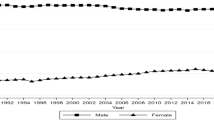Abstract
Adjustments to fertility policy in recent years have led to changes in fertility level and these have had an impact on the overall population and have implications for labor force participation. In particular, fertility policy adjustments have had a direct influence on the female labor force. This paper uses data from China Family Panel Studies in 2016 to test the impact that increases in the number of child births that have occurred as result of shifts in fertility level are having on women’s labor force participation. Our findings show that the influence of the number of children on the participation of married women in the labor force is shown by a “U-shaped” non-linear relationship dominated by substitution effect and income effect. The turning point of urban married women from the substitution effect to the income effect occurs earlier than it does for rural married women. This means that urban married women are more sensitive to the economic pressure that results from child births. Therefore, the Universal Two-Child policy, introduced at the beginning of 2016, inevitably has a direct negative effect on women’s labor force participation. Helping women to maintain work-family balance has become a problem that must be addressed at present.
Similar content being viewed by others
References
AlAzzawi, S., & Hlasny, V. (2019). Household asset wealth and female labor supply in MENA. Quarterly Review of Economics & Finance,73, 3–13.
Angrist, J. D., & Evans, William N. (1998). Children and their parent’s labor supply: Evidence from exogenous variation in family size. American Economic Review,88(3), 450–477.
Bloom, D. E., & Canning, D. (2007). Demographic change, fiscal sustainability, and macroeconomic performance. Public Policy & Aging Report,17(4), 1–23.
Bloom, D. E., Canning, D., Fink, G., & Finlay, J. E. (2009). Fertility, female labor force participation and the demographic dividend. Journal of Economic Growth,14(2), 79–101.
Budig, M. J. (2003). Are women’s employment and fertility histories interdependent? An examination of causal order using event history analysis. Social Science Research,32(3), 376–401.
Chen, Y., & Jiang, H. (2018). From fertility desire to fertility behavior: An analysis of the determinants of the second child-bearing decision-making under the background of nationwide Two-Children Policy. South China Population,33(02), 47–60.
Cheng, B. S. (1996). An investigation of cointegration and causality between fertility and female labour force participation. Applied Economics Letters,3(1), 29–32.
Hughes, B. (1972). Direct income and substitution effects in participation decisions. Journal of Political Economy,80(4), 793–795.
Liu, J., & Tang, D. (2015). China’s universal two-child policy: Grounds, effects and strategies. Population Research,39(06), 3–12.
Luo, J., & Miao, Y. (2018). The effect of number of children on female labor force participation rate—based on dynamic monitoring data of floating population in 2014. The World of Survey and Research,12, 36–43.
Mehrotra, S., & Parida, J. K. (2017). Why is the labor force participation of women declining in India? World Development,98, 360–380.
Shen, K., Zhang, Y., & Yan, P. (2012). Family structure and female labor force participation in China. Population Research,36(05), 15–27.
Silles, M. A. (2016). The impact of children on women’s labor supply and earnings in the UK: Evidence using twin births. Oxford Economic Papers,68(1), 197–216.
Song, J., & Zhou, Y. (2015). Married women’s fertility and its effect on their employment: The role of economic assistance and care support. Collection of Women’s Studies,04, 16–23.
Wei, N., & Su, Q. (2013). The Effect of fertility on rural married women's non-agricultural employment. Issues in Agricultural Economy,34(07), 30–34.
Wu, Y. (2015). Untangling income and substitution effect: An explanation for changes in urban female labor force participation. Labor Economic Research,3(04), 3–30.
Yao, X., & Tan, L. (2005). Family income and labor force participation of married women in urban China. Economic Research,07, 18–27.
Zhang, C. (2011). Impacts of number of children on the labor supply and wage earnings of married women. Population & Economics,05, 29–35.
Author information
Authors and Affiliations
Corresponding author
Rights and permissions
About this article
Cite this article
Tong, Y., Gong, Q. The impact of child births on female labor force participation in China. China popul. dev. stud. 3, 237–251 (2020). https://doi.org/10.1007/s42379-019-00041-6
Received:
Accepted:
Published:
Issue Date:
DOI: https://doi.org/10.1007/s42379-019-00041-6




